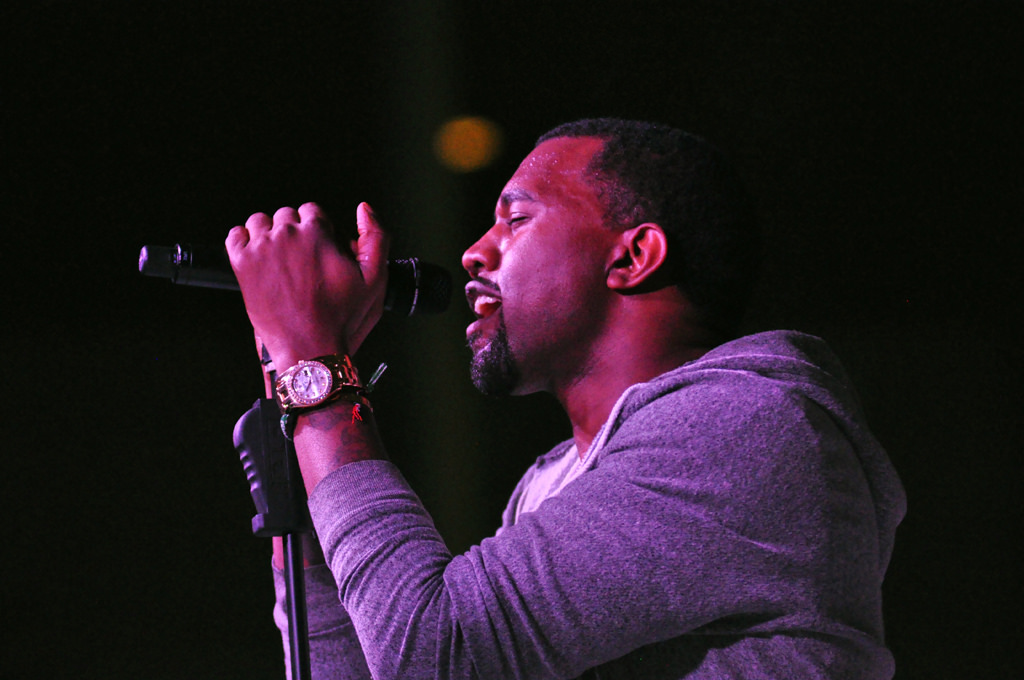When The Life of Pablo was released, I came across this tweet linking Kanye’s previous three albums to the three phases of Pablo Picasso’s artwork, which might’ve been a stretch, but definitely resonated with the singer’s ability to blend the visual with the musical. One of the most important aspects of Kanye’s art is the cover of his albums, each one speaking to his personal transformation as a rapper while staying true to the overall message of the music. Many of the albums have alternate covers, showing the complexity of the songs and their subsequent styles. In this analysis, we rank every Kanye album based on cover art and how much the art adds to the album itself.
- The Life of Pablo (2016)
The cover artwork for The Life of Pablo features two photos, one of a family and the other of woman with a figure similar to Kim Kardashian. In addition to these images, the text “WHICH / ONE” is repeated many times. Through the songs on this album, Kanye creates a narrative that reveals how uncertain he is of his life. This is one of Kanye’s most vulnerable albums, with many songs conveying a sense of doubt and revealing his fear about whether he is a good husband and father. Based on the context of these songs, the text on the album cover is particularly striking, as it seems to match the internal strife expressed by Kanye in each of the songs on the album. Lastly, the soft orange backdrop with the faded photos gives the cover a more vintage feel, portraying the singer’s juxtaposed maturity with his constant self-questioning, making it the best cover of all eight major albums.
- MBDTF (2010)
The different album covers that accompany MBDTF, cohesive in that each is a semi-surreal painting set on a striking red backdrop, perfectly portray the meaning behind Kanye’s masterpiece of an album. There are different moods that accompany the music, with the Ballerina painting alluding to his song “Devil in a New Dress” and the image of Kanye’s severed head with a sword through it alluding to “Power.” The covers of MBDTF help boost the work to its stardom, and reflect how striking the music is. Furthermore, the fact that the album’s original cover art got banned due to its explicit nature (Kanye tweeted that it’s ridiculous that a painting of a half woman-half monster had to be censored) speaks to the struggle between making profitable music and being forced to restrain yourself when you reach a certain level of recognition. Finally, the surrealism of the songs, in both lyric and style, is mirrored by the literal surrealism in the cover art.
- 808s & Heartbreak (2008)
The cover of 808s & Heartbreak features a set of hands tearing apart a heart against a gray background. On the left side of the cover is a multi-colored stripe. This album is all about the devastation Kanye faced after a breakup and the death of his mother, and he isn’t hiding it: by singling out a broken heart, the cover perfectly matches the message of the songs on this album. 808s also incorporates elements of electronic music not usually present in other works. The colored stripe on the side evokes the new, bright sound of the electronic music, and the coming end of Kanye’s agony. However, the color has very little presence in the sea of gray, solidifying the ultimate sadness of this album. Most importantly, this artwork feels like the transition from Kanye’s original trilogy to his later, more mature musical works, and therefore deserves a place in his top three covers.
- Yeezus (2013)
Yeezus essentially does not have any cover art. Although Kanye made many conceptual changes while finalizing this album, he ultimately decided on a clear CD case with red tape on the side. This minimalism contrasts the intense nature of the album. In a way, this contrast makes the brutal nature of the songs on Yeezus stand out even more: the cover is unassuming, which makes the power of these songs all the more shocking. The only downside is that the cover could have been more impactful if it had been a bit more creative. Minimalism has its place, but with such brutal, breathtaking music, you’d hope to see it reflected in the artwork.
- The College Dropout (2004)
The cover of The College Dropout features the bear that would become Kanye’s signature for his next two albums. The bear is hunched over and staring at the ground in an exhausted manner, which matches the title of the album and the message of songs like “School Spirit.” This album is certainly a rebellion against the hip-hop that’s prevalent at the time; the bear looks frustrated, which links to Kanye’s desire to make changes in the music world. What makes this album cover stand out even more is the ornate gold frame. Aside from the upbeat sound of many of the songs, Kanye also tackles deeper issues in songs like “Jesus Walks.” The frame contrasts the modest bear sitting on the bleachers, which highlights how Kanye is using the familiar medium of rap to tackle serious, more complex issues.
- Graduation (2007)
This album was host to some of Kanye’s most mainstream music, and therefore matches the more poppy cover. While the artwork itself is a bit outlandish with the vibrant colors and the crazy scene it depicts, it does reflect the music and is therefore still up there with the better covers. It’s also hard to forget who Kanye himself was at that time; circa 2007, he was wearing those weird glasses with the lines through theme and collaborating with Daft Punk. Every song on that album was a banger, but it lacked the substance that came with his later music. Similarly, the crazy art on the cover is good, but it’s not mature.
- Late Registration (2005)
This is why we weren’t ranking albums and just covers: every album is so good in its own right, and every one is different, making it nearly impossible to give definitive positions for the music itself. Well, the cover art for Late Registration is second to last because it doesn’t do anything for the music except to show the Kanye-representing teddy bear walking through some doors to show that he’s back in college. It’s an obvious representation, and its only redeeming quality is that it continues the original trilogy’s motif. However, it’s not artistic, and it doesn’t use the color contrast that makes his other album art so magnificent.
- Watch The Throne (2011)
Even though the album itself was a testament to the power of Kanye and Jay Z, this cover was bland and did absolutely nothing for the visual aspect that usually comes with Kanye’s art. It felt like an afterthought to the confident, assertive nature of the music. Even though it was designed by Givenchy Creative Director Riccardo Tisci, it had the power to be so much more artistic, so much more intriguing, and so much more relatable to the content it represents. We get it, you guys are royalty, you don’t need a gilded cover to prove it.
Authors: Claire Goldberg and Theresa Werick






